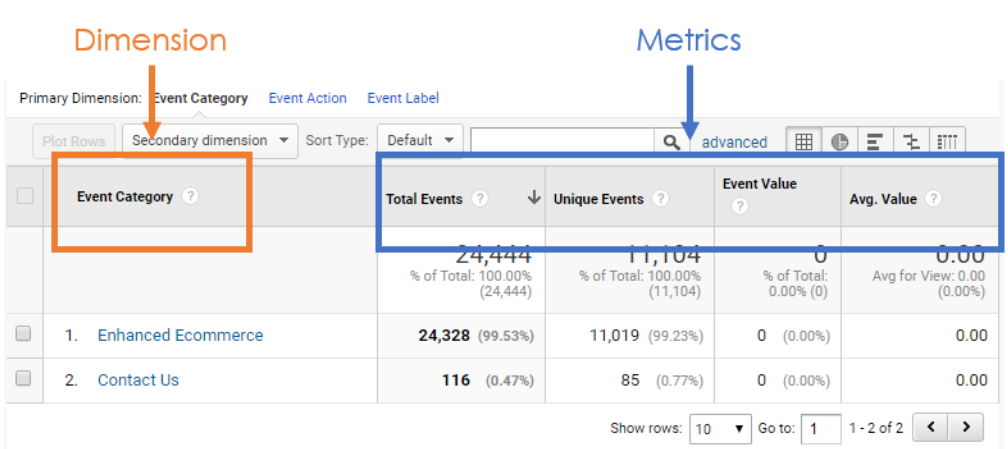Transform Your Analytics Approach With Second Measurement in Google Analytics
By integrating additional measurements into information evaluation, a brand-new layer of understandings arises, losing light on intricate user habits and interactions. The tactical application of second measurements holds the crucial to opening a prize chest of indispensable info that can revolutionize exactly how services act and interpret upon their data.
Understanding Additional Dimensions in Google Analytics
Additional measurements in Google Analytics give additional context to main information by enabling customers to examine metrics throughout a second dimension, using deeper insights into customer habits and communications on a site. Secondary Dimension in Google Analytics. While key dimensions give essential data factors such as pageviews, bounce rate, and session duration, additional measurements provide a more in-depth sight by segmenting the main information further. This segmentation permits individuals to evaluate metrics in mix with an additional dimension, such as website traffic sources, demographics, or user actions
Advantages of Utilizing Secondary Dimensions
Making use of additional dimensions in Google Analytics uses a tactical benefit by enhancing the depth of analysis and offering a more detailed understanding of individual communications and actions on a website. By incorporating secondary dimensions, experts can get useful insights into the performance of particular segments or variables within their data. This allows a much more detailed exam of user behavior past surface-level metrics, enabling a much deeper expedition of the aspects affecting user involvement and conversions.

How to Implement Additional Dimensions
When including secondary dimensions in Google Analytics, one essential step is to choose the pertinent metrics and dimensions to enhance the analysis procedure. Clicking on this switch will certainly open up a drop-down menu listing different measurements that can be added to your key measurement for much deeper insights.
After choosing the suitable additional dimension, such as 'Source/Medium' or 'Gadget Group,' Google Analytics will certainly present the information in a more comprehensive style, permitting you to cross-analyze various aspects of user behavior. Remember to try out different combinations of main and additional measurements to reveal beneficial patterns and fads that can educate your advertising and marketing strategies. By implementing secondary dimensions attentively, you can gain a much more detailed understanding of your web site or application performance and make data-driven decisions to optimize your digital visibility.
Studying Information With Additional Measurements
Improve your data evaluation in Google Analytics by integrating secondary measurements to dive deeper right into individual actions patterns and maximize your digital marketing methods successfully - Secondary Dimension in Google Analytics. By adding second dimensions to your key data, you can gain useful understandings that can aid you make informed decisions about your internet site or app efficiency
Evaluating information with additional measurements permits you to segment your key data better, offering an extra extensive sight of user communications. For example, incorporating the main dimension of 'source/medium' with an additional measurement like 'landing web page' can reveal which certain web pages are driving traffic from various resources. This info can be crucial in fine-tuning your content technique or enhancing your ad campaign to increase conversions.
Moreover, making use of secondary measurements allows you to identify connections in between different metrics, helping you comprehend the effect of numerous go now variables on user behavior. Whether it's evaluating demographics together with customer engagement metrics or device groups with conversion rates, secondary dimensions equip you to discover concealed patterns and patterns that can lead your marketing efforts.
Optimizing Performance With Secondary Dimensions
To improve the effectiveness of data analysis and decision-making in Google Analytics, integrating secondary dimensions is key to optimizing performance metrics and acquiring deeper insights into user behavior patterns. By making use of second measurements, experts can dig beyond surface-level data and uncover useful relationships that might otherwise go unnoticed. This optimization strategy enables businesses to customize their advertising and marketing initiatives better, determine areas for renovation in internet site functionality, and enhance overall customer experience.
Additional dimensions offer an even more detailed view of customer communications by offering additional context to key information metrics. As an example, pairing the key dimension of 'landing web page' with an additional dimension like 'tool category' can reveal whether specific tools are extra most likely to drive engagement on specific landing pages. This insight can educate responsive style improvements or targeted advertising approaches to improve efficiency.

Verdict
To conclude, the integration of second dimensions in Google Analytics gives organizations with an effective device to enhance their analytics approach. Secondary Dimension in Google Analytics. By delving deeper right into user actions and interactions, marketers can reveal important understandings that can drive performance optimization and boost the total individual experience. Leveraging second measurements allows for an extra extensive evaluation of data, causing even more educated decision-making and customized marketing initiatives
Second dimensions in Google Analytics supply additional context to main information by allowing individuals to assess metrics across a second measurement, offering deeper insights right into user habits and communications on a site. While main measurements provide essential information factors such as pageviews, bounce price, and session duration, additional measurements supply a more comprehensive view by segmenting the primary data additionally.One of the vital advantages of using secondary dimensions is the capability to discover relationships and patterns that might not be right away evident useful reference when assessing information with key measurements alone.When incorporating secondary dimensions in Google Analytics, one vital step is to choose the appropriate metrics and measurements to enhance the evaluation procedure. Combining the main measurement of 'landing web page' with a secondary dimension like 'device category' can disclose whether particular tools are extra most likely to drive interaction on certain Read Full Article touchdown pages.